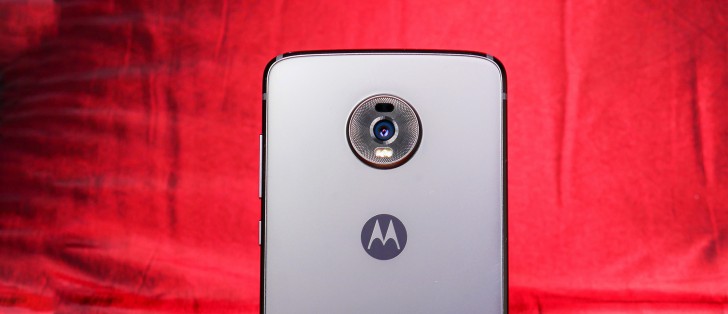Motorola Moto Z4 review

Biggest sensor on a Moto
The Moto Z4 has come a long way since the original Moto Z and one aspect that has also evolved with the lineup is the camera. The first Moto Z caught the end of the megapixel race with a 16MP sensor until the Moto Z2 launched with dual 12MP cameras. Then, the Moto Z3 had identical dual cameras to those of the Z2.

Today, the Moto Z4 comes with a 48MP camera behind an f/1.7 aperture lens. The camera uses Quad Pixel technology which outputs 12MP images, equivalent to a 1.6um pixel size. There is also a dual-tone LED flash and OIS. The camera uses a combination of phase-detect autofocus and laser-assisted autofocus.
Motorola was never known for putting great focus on its camera optics. As a result, the Moto Z's competition always had superior camera performance. We hoped that the camera would be great when we heard that it was coming with a huge 48MP camera sensor.
Unfortunately, the added resolution was not enough to improve the camera quality over the Z3's run-of-the-mill camera - which actually re-used the dual-camera from the Z2 Force.
The Moto Z4 didn't take horrible photos, we just think that there are much better cameras in the same price range.
That said, let's take a look at how the Moto Z4 performed in this department. Let's start with the UI.
Camera UI
Motorola's camera interface is not very complicated. The camera's got a dedicated video viewfinder, which makes framing easy for shooting video and the video mode is just one swipe away. Swiping in the other direction will show you more available modes - there aren't too many more of them.

The main camera offers a portrait mode, which can only detect persons' faces, there's a spot color mode, and a Night Vision mode. There is also a cinemagraph mode that can shoot short videos and you can manually select which areas you'd like to stay in motion.
The main camera outputs up to 12MP images but also offers a variety of cropped aspect ratios outside of the default 4:3. It also supports 4K video at up to 30fps.
Meanwhile, the front 25MP camera also uses the Quad Pixel technology which outputs a 6.25MP image. This camera supports 1080p video at up to 30fps but does not support Night Vision.
There are plenty of settings in the camera app, but one that we didn't find is a full-resolution shooting mode that can take advantage of the huge sensor. Then again, many smartphones using these high-resolution cameras only output in a fraction of the total resolution as a result of pixel binning.
Image quality
Daylight images shot with the Moto Z4 were generally good. We wish that the white balance was a bit more consistent between shots. It usually seems to be either pretty accurate or just shifts a bit cooler than it should. Meanwhile, sometimes colors appeared to be more saturated in shots with HDR On versus shots where HDR didn't kick in - the latter resulted in washed out colors.
Details here are not on par with the Moto Z3. This new camera doesn't seem to be taking full advantage of the 48MP sensor - either the image processor didn't do such a great job, or Motorola opted to use cheap optics. With details, there is again another inconsistency between photos with and without HDR. You'll notice some of the samples look oversharpened, which really affects the look of foliage.
When taking closeup shots of something like a flower, the camera's natural bokeh (f/1.7 lens) is overprocessed in the resulting photo. You can clearly see this in the penultimate daylight sample from the Moto Z4.
It isn't all terrible - the Moto Z4's Quad Pixel technology ensured nearly no noise in many of the daytime samples we took.
Here are some comparison photos shot with the Google Pixel 3a XL.
Night Vision shots were pretty much hit or miss. If you had enough surrounding light such as light from a well-lit parking lot - the shots are not bad. It's when the camera needs to bring more out of the scene that the camera really struggles. Night Vision is not for all levels of night.
Night Vision shots are slightly oversharpened and it seems like Motorola modeled its behavior after the Pixel 3. Rather than bring up shadows, Night Vision actually keeps the shadows down and reduces black levels even lower than standard shots. Meanwhile, highlights are brought down to match the dark look of the scene. You can really tell in the second shot of each set above.
Here are some comparison shots with the Google PIxel 3a XL using Night Sight.



Night Sight shot on Pixel 3a XL
Selfie
The Moto Z4 has a 25MP selfie camera with an f/2.0 aperture lens. The front camera also uses the same Quad Pixel technology as the main camera so the images it outputs are 6MP in resolution.
Selfies came out better than anticipated with a good amount of detail on the subject and fairly good dynamic range in the background.
Like the main camera, the Quad Pixel does a good job of keeping noise to undetectable levels. Since the final resolution is not very high, the selfie camera takes flattering photos, even in harsh light.
We definitely like this camera's selfies better than those from the Pixel 3a XL. The images look much more flattering and the slightly cool color temperature of the Pixel 3a XL doesn't work too well with people's warm skin tones. Here are a few for comparison.




Selfies shot on Pixel 3a XL for comparison
The Moto Z4 can also take portrait selfies and they look quite good. Images are consistent with their non-portrait counterparts and the bokeh is soft and mostly accurate - unless you peep those pixels.
Video recording
The Moto Z4 can record 4K video at 30fps, and 1080p up to 60 fps. Again, there's a dedicated viewfinder that's easily accessible from the default viewfinder. Within the video viewfinder is a stabilization toggle. Keep in mind that all cameras crop in on the frame to compensate for excessive movement.
Video quality was fairly good. 4K videos saw nice-looking colors and great details. Noise is well concealed in areas of the sky while the foliage, although a bit oversharpened in the distance, looks like it's breathing with the wind. We can spot some noise in the darker colors of the asphalt. Meanwhile, the dynamic range could be a bit better.
As you will see in the sample below, one annoying feature of the camera is the rapid fluctuations of the exposure as cars leave the frame to the right. We really think exposure control should be more gradual to allow for nicer footage.
1080p video looked just okay. We think a bump in sharpness could help the camera in this mode while a slight reduction in sharpness for the 4K mode could help a bit. Colors are okay but just like the 4K sample, dynamic range could be a bit better.
Reader comments
- Anonymous
- 28 Apr 2023
- Tmf
Model z3 force doesn't exist.
- DAXING GHANCHI
- 05 Apr 2023
- PAm
moto z3 force better then z4
- Anonymous
- 31 Dec 2022
- 4iQ
I love this phone it takes the best pictures ever The screen cracked and it quit working so I went with the edge I hate it camera is not near as good as the Z4 my pictures were so awesome taking with the Z4 I cannot say that about the edge most of th...




























